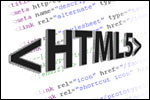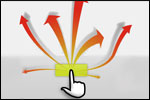 Inline-block and float seems to be alike at first sight. What is more, both these statements can be used to accomplish the same visual effect. You can use them both to create a whole range of other commonly used web patterns. Let’s try to find the differences that help you to make the right choice.
Inline-block and float seems to be alike at first sight. What is more, both these statements can be used to accomplish the same visual effect. You can use them both to create a whole range of other commonly used web patterns. Let’s try to find the differences that help you to make the right choice.
Continue Reading...
Previous post
 Suppose it is unnecessary to explain in details the specifics of the inline-block display value. The main problem with it is that it has no support in older browser versions. IE6 and IE7 have partial support only while FF2 has –moz specific support. Let’s try to use the following to fix the problem…
Suppose it is unnecessary to explain in details the specifics of the inline-block display value. The main problem with it is that it has no support in older browser versions. IE6 and IE7 have partial support only while FF2 has –moz specific support. Let’s try to use the following to fix the problem…
Continue Reading...
Next post
Previous post
 Many web developers still use HTML as the best way for constructing to add CSS, javascript and some other enhancements to their web documents. However, more and more people start talking about semantic value of HTML. Sometimes, we take the advice too literary and this may lead to various unnecessary problems with HTML.
Many web developers still use HTML as the best way for constructing to add CSS, javascript and some other enhancements to their web documents. However, more and more people start talking about semantic value of HTML. Sometimes, we take the advice too literary and this may lead to various unnecessary problems with HTML.
Continue Reading...
Next post
Previous post
 Some web developers use extra wrapper with a background image over empty elements every time they are trying to create triangle. There are several techniques to create triangles in CSS and here are some of them to try. Using the following tips you will take advantage of a browser drawing the borders at angles.
Some web developers use extra wrapper with a background image over empty elements every time they are trying to create triangle. There are several techniques to create triangles in CSS and here are some of them to try. Using the following tips you will take advantage of a browser drawing the borders at angles.
Continue Reading...
Next post
Previous post
 Sometimes even a simple issue can become a real problem with CSS. The main thing is to make it cross-browser. One of such examples is spreading a list evenly across the total width of the container. Let’s try to solve this step by step. Note that any improvements are welcome.
Sometimes even a simple issue can become a real problem with CSS. The main thing is to make it cross-browser. One of such examples is spreading a list evenly across the total width of the container. Let’s try to solve this step by step. Note that any improvements are welcome.
Continue Reading...
Next post
Previous post
 Classes help you to structure your document as well as add semantic meaning to elements where html falls short. It is better not to apply too many classes on one single element and avoid classes that contain behavior instead of semantic meaning. In case you use the class attributes correctly, you will get flexible and future proof structure to your documents.
Classes help you to structure your document as well as add semantic meaning to elements where html falls short. It is better not to apply too many classes on one single element and avoid classes that contain behavior instead of semantic meaning. In case you use the class attributes correctly, you will get flexible and future proof structure to your documents.
Continue Reading...
Next post
Previous post
 Trying to be a professional web designer we try to learn everything necessary about web standards and even more. Now you know a lot about screen readers and people with disabilities browsing the web, how machines differ from humans as well as about semantics and syntax. All this is quite useful.
Trying to be a professional web designer we try to learn everything necessary about web standards and even more. Now you know a lot about screen readers and people with disabilities browsing the web, how machines differ from humans as well as about semantics and syntax. All this is quite useful.
Continue Reading...
Next post
Previous post
 At-rules are instructions or directives to the CSS and can be used for a variety of purposes. There are quite a lot of facets specific to the page at-rule. However, many at-rules don’t work on any browser, so we offer you the basic information concerning at-rules that help you to get the idea without wasting your time on reading a lot of stuff.
At-rules are instructions or directives to the CSS and can be used for a variety of purposes. There are quite a lot of facets specific to the page at-rule. However, many at-rules don’t work on any browser, so we offer you the basic information concerning at-rules that help you to get the idea without wasting your time on reading a lot of stuff.
Continue Reading...
Next post
Previous post
 Here you can find some general information about position and floating. The main issue of this article is the larger chunks of a page. However, you can represent any web design with the right combination of positioning, floating, margins, padding and borders. Just look at each part of the page as individual chunk.
Here you can find some general information about position and floating. The main issue of this article is the larger chunks of a page. However, you can represent any web design with the right combination of positioning, floating, margins, padding and borders. Just look at each part of the page as individual chunk.
Continue Reading...
Next post
Previous post
 There’s nothing special about how most of HTML elements work. Thus, you can make up most pages from a few tags that can be styled as you wish. The browser’s default visual representation of most HTML elements consist of varying font styles, margins, padding and display types.
There’s nothing special about how most of HTML elements work. Thus, you can make up most pages from a few tags that can be styled as you wish. The browser’s default visual representation of most HTML elements consist of varying font styles, margins, padding and display types.
Continue Reading...
Next post
Previous post
 Inline-block and float seems to be alike at first sight. What is more, both these statements can be used to accomplish the same visual effect. You can use them both to create a whole range of other commonly used web patterns. Let’s try to find the differences that help you to make the right choice.
Inline-block and float seems to be alike at first sight. What is more, both these statements can be used to accomplish the same visual effect. You can use them both to create a whole range of other commonly used web patterns. Let’s try to find the differences that help you to make the right choice. 







